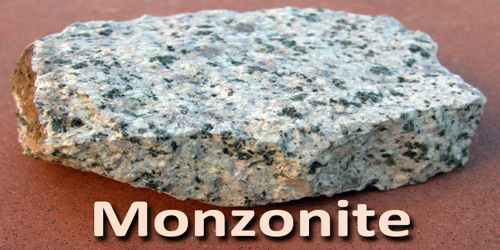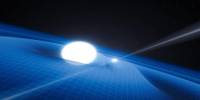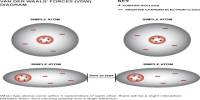Monzonite
Definition
Monzonite is an igneous rock composed chiefly of plagioclase and orthoclase, with small amounts of amphibole, pyroxene, and biotite. Monzonite contains little or no quartz. The rocks are of granitic appearance, usually rather dark grey in colour and fine to moderately coarse grained. It is composed of approximately equal amounts of plagioclase and alkali feldspar, with less than 5% quartz by weight.
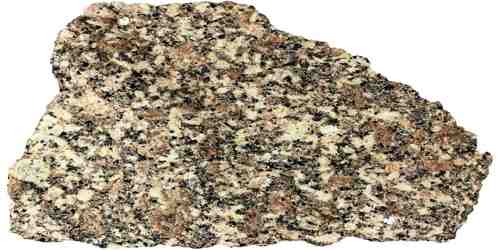
Quartz, nepheline, and olivine, which are occasionally present, produce quartz, nepheline, and olivene monzonites. It is a relatively uncommon rock type. It usually does not form its own plutons. Monzonitic magma most likely forms only a part of a generally more acidic (granitic) intrusion. Although monzonite itself is not a particularly well-known or widespread rock type, but it has given part of its name (monzo-) as a prefix to several other varieties of plutonic rocks (monzogranite, monzogabbro, foid monzosyenite, etc.).
With an increase in calcic plagioclase and mafic minerals the rock type becomes a diorite. The volcanic equivalent is the latite.
Occurrences and Properties of Monzonite
In the type region of Monzoni, Italy, in the Italian Tirol, these minerals rarely occur as major constituents; moreover, in Monzoni the plagioclase is often calcium-rich (labradorite) and commonly shows prominent zoning. Rocks similar to those of the type area have been described from Norway (akerite), Montana (yogoite, shonkinite), and Sakhalin Island off the Pacific coast of Russia, and other localities throughout the world. Monzonite is not a rare rock type, but it generally occurs in rather small, heterogeneous masses associated with (and perhaps gradational to) diorites, pyroxenites, or gabbros.

Most important minerals in monzonitic rocks are definitely feldspars. Small amounts of quartz and feldspathoids may occur. Most important mafic minerals are biotite, augite, and hornblende. Sphene (titanite) and apatite are common accessory minerals. Feldspar is often perthitic (plagiopclase in alkali feldspar) or antiperthitic (alkali feldspar in plagioclase), which makes it harder to visually estimate whether the rock sample is monzonite or not.
The physical properties of Monzonite depend on its formation. Physical properties of rocks play an important role in determining its applications in various fields. Rocks are rated on the on the Moh’s Hardness Scale which rates the rocks on the scale from 1 to 10. Rocks with hardness 1-3 are soft rocks from 3-6 are medium hardness rocks and 6-10 are hard rocks. The hardness of Monzonite is 6-7 whereas its compressive strength is 310.00 N/mm2. Streak is the color of rock when it is crushed or powdered. The streak of Monzonite is white whereas its fracture is not available. Luster of Monzonite is the interaction of light with the surface of Monzonite. Luster of Monzonite is subvitreous to dull. Monzonite cleavage is not available. The specific gravity of Monzonite is 2.8-3. Monzonite is opaque in nature whereas its toughness is not available.
Thermal properties of Monzonite play an important role in geology. Specific heat capacity, resistance offered by the rock to heat, water, pressure etc. are some of the thermal properties of Monzonite.
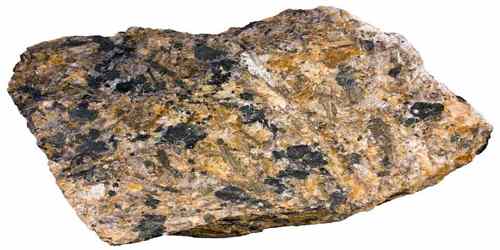
Usage of Monzonite
It may not be very widespread rock type, but the usage of the term “monzonite” is scarcer still. Many “syenite” and “granite” samples are actually monzonites. It may be partly due to the different traditions in Europe and North America which can create confusion. Quartz monzon. In America may be granite (monzogranite) or adamellite in Europe. “Adamellite” itself is unfortunately also ambiguous term.
Reference:
